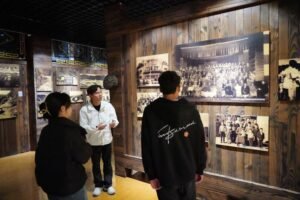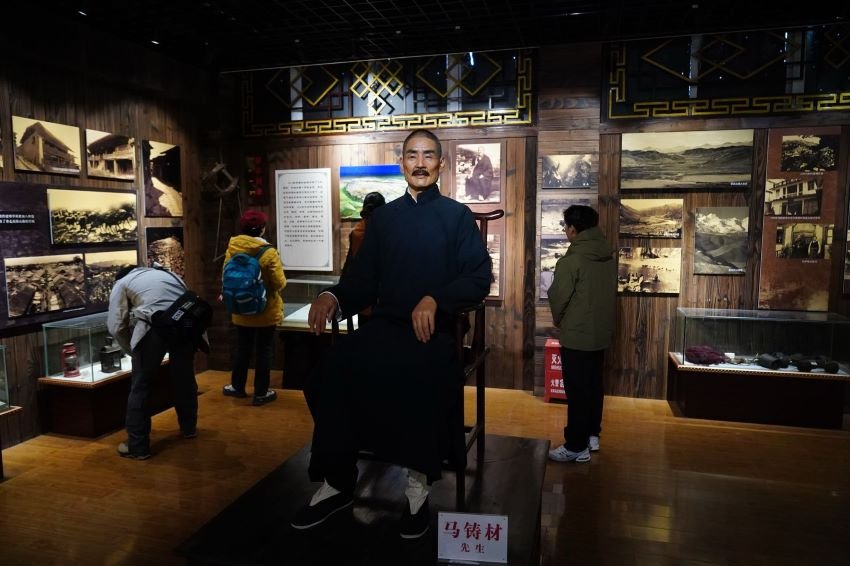Dukezong (TDI): During the winter break, the “Shangri-La” of the world, the Diqing Tibetan Autonomous Prefecture in Yunnan Province, is teeming with visitors. Inside the “Shangri-La Tea Horse Road Museum” located in the ancient city of Dukezong, tourists are seen visiting in an orderly manner. The statue of the patriotic overseas Chinese Ma Zhucai stands silently, with his story of traveling along the Tea Horse Road for half a century, later settling in India to donate for the rescue of his country and establish a Chinese school unfolding behind the statue.
Born in 1890 in a poor family in the ancient city of Dukezong in Zhongdian (now Shangri-La City), Ma Zhucai grew up cutting firewood and herding livestock to make a living, never having attended school.
At the age of 15, he went to work at a local business, and within less than three years, he was promoted to a junior clerk.
He was entrusted with leading a horse caravan to transport tea and other bulk goods in southern Yunnan and the Sichuan-Kham region.
At the age of 19, he led his horse caravan to Xizang for the first time, becoming the youngest “Maguotou” (leader of the horse caravan) of the time.
Wang Qiang, a young guide at the museum, points to the copper bells, woolen felt, pots, and bowls of the horse caravan on display, explaining that the Tea Horse Road, with a history of over a thousand years, is an important economic and cultural corridor in southwestern and northwestern China.
Using the horse caravan as transportation, tea from Yunnan was transported to Xizang, while wool, medicinal herbs, and furs from Xizang and India flowed into Yunnan.
Also Read: Chinese He (和) Culture and its Implication for China-Pakistan Relations
There is a saying, “Eight stations for the poor, eight stations for the rich, and eight more if neither poor nor rich.”
The Tea Horse Road’s 24 stations pass through the dangerous, narrow, and swift rapids of the Jinsha River Valley, as well as snow-covered mountain passes at altitudes of over 5,000 meters. Mules, horses, and their cargo had to be ferried across the Lancang River using ropes… The journey was extremely perilous.

“Back then, it was not uncommon for caravan porters to go without returning. Many visitors consider this unbelievable because today, Shangri-La is accessible by air and highways, and even a high-speed train was opened in 2023, making it a world-renowned tourist destination,” says Wang Qiang.
“As my hometown has developed more and more, I also chose to return and work here after graduating from university.”
Over a hundred years ago, the young Ma Zhucai was determined to make his mark.
At the age of 24, he established his own horse caravan, purchasing tea from southern Yunnan and transporting it to Xizang, selling as he went.
After crossing from Tibet into India and arriving in Kalimpong, he gained a broader perspective. Many Han and Tibetan merchants were registering companies or business houses in India to engage in trade.
Ma Zhucai made a bold decision—to settle in Kalimpong. In 1923, he founded the “Zhuji” business (a trading company), which gradually gained fame in Lhasa and Qamdo in Tibet, Kangding in Sichuan, as well as in Kunming, Lijiang, and Zhongdian in Yunnan.
Furthermore, to resist the importation of tea into Xizang from India and the UK, Ma Zhucai helped establish the Xiaguan Kangzang Tea Factory in Yunnan, producing the “Baoyan” brand of tea, which began production in 1941 and continues to this day.
Also Read: China’s Relaxed Policies Boost Tourism
He also purchased land in Lijiang to introduce economic crops such as American tobacco, Indian flax, and tung trees, as well as improving livestock by introducing Dutch dairy cows, Qinghai Xining horses, and Shaanxi mules.
His open-minded and bold approach to business was ahead of its time.
After the outbreak of the Anti-Japanese War, many refugees and overseas Chinese poured into Kalimpong, including numerous students and children of school age.
Ma Zhucai worked tirelessly to establish a school, and eventually, together with several local community leaders, he founded the Zhonghua School.
The school was completed and opened in 1941. It offered Tibetan and English courses and admitted Indian students, training talented individuals.
The school named its assembly hall “Zhucai Hall” and elected Ma Zhucai as the honorary chairman.
On October 1, 1950, the Zhonghua School in Kalimpong raised the Five-Star Flag for the first time and played the Chinese national anthem.
In addition, Ma took the initiative to make donations and mobilized other businesses to contribute a total of 250,000 Chinese National Currency (CNC) to purchase aircraft for China.
He also initiated the “Anti-Japanese Monthly Donation” campaign in Kalimpong, which persisted for many years, expressing the deep patriotism of overseas Chinese.
After the peaceful liberation of Xizang, Ma Zhucai actively supported Xizang’s development, purchasing and transporting steel, gasoline, food, and other essential supplies for the construction of the Qinghai-Xizang and Sichuan-Xizang highways.
He was later commended by the Xizang Military Command. He also contributed to public welfare, building numerous roads and bridges along the Tea Horse Road and constructing schools in remote mountain areas.
Also Read: China’s Tourism Boom Gains Global Attention
Memorial tablets commemorating his achievements are still preserved in Diqing (Yunnan), Lijiang (Yunnan), Lhasa (Xizang), and other locations, and are recorded in local history.
Before the 1953 National Day, Ma Zhucai received a notice from the Chinese Embassy in India, informing him that he would serve as the head of the overseas Chinese delegation from India and Pakistan and attend the National Day celebrations in Beijing.
During his time in Beijing, He Xiangning, then head of the Overseas Chinese Affairs Committee of China, met with Ma Zhucai and highly praised his patriotism, gifting him a hand-painted “Tiger Picture” with the inscription “Loving the Great Motherland.”

In 1960, Ma Zhucai was falsely accused and imprisoned in Kalimpong, but was released after the intervention of the Chinese government. In March 1962, he returned to China and settled in Kunming.
In October 1963, he passed away due to a recurrence of heart disease.
After Ma Zhucai’s passing, his grandson He Qiang converted Ma Zhucai’s former residence into the Shangri-La Tea Horse Road Museum.
In the guestbook at the museum’s exit, visitors from countries such as the United States, Canada, the United Kingdom, Mexico, Thailand, and others have expressed their appreciation in various languages: “Thanks to the museum for letting me learn about local history, culture, and stories. It’s truly magnificent!” “The hardships of the Tea Horse Road are incredible, and Ma Zhucai’s patriotism is deeply moving.”
Wang Qiang has worked at the museum for two years and has already welcomed over ten thousand visitors.
To help more people learn about the history of the Tea Horse Road and Ma Zhucai’s story, the museum has launched a stamp collection activity that appeals to young people, encouraging visitors to share their experiences on social media.
Now in his old age, He Qiang resides in Lijiang at a lower elevation. When his health allows, he returns to the museum once a month to handle related matters.
The high-speed rail has made travel very convenient now; it takes about an hour to get here. “The Tea Horse Road, once traveled by my grandfather, has now transformed into a wide, smooth avenue,” he says.
Farkhund Yousafzai is an Associate Editor at The Diplomatic Insight.



